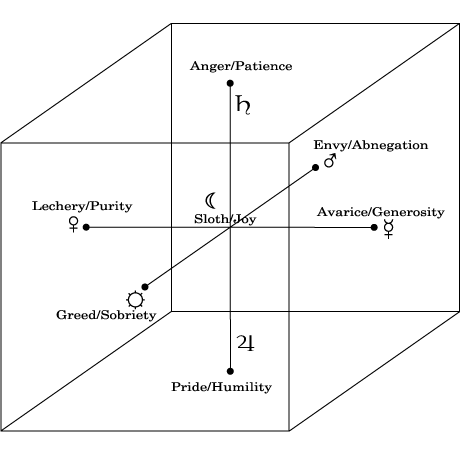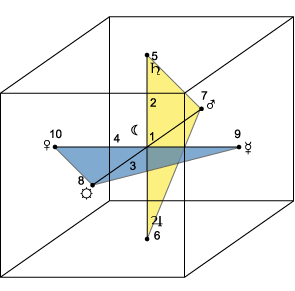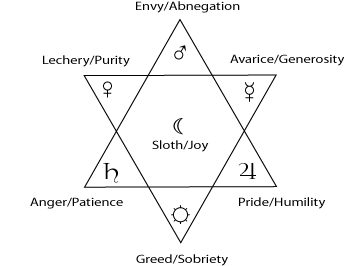
Cube of Space:
Planetary Contrary Energies as Virtues and Vices: Seven / 7 Deadly Sins
Sepher Yetsira Index

| ||
|
The Cube of Space provides an integrated model for human experience and development.
Without the 3-dimensional model of the Cube, we miss, for instance, the natural
pairing of six of the classical virtues and vices, and the location of the seventh.
From the perspective of the Cube, we can understand the logic of the pairings and positions of these energies which manifest on the emotional and experiential level as sins/vices and virtues. On the up-down Existential axis, anger/patience and pride/humility are the emotional polarities of the identity of self and other. We get angry at others (or their psychological introjects inside us) and feel ashamed of ourselves for what others might think. On the front-back Life axis, envy/abnegation and greed/sobriety represent the emotional polarities that define the trajectories of our lives: what we envy -- we don't have it but we might get it -- shapes our futures, and our greed -- to amass and accumulate -- builds structures out of unconscious memory. The third, left-right axis of Interpenetration weaves Identity and Life into an experience of Being with the energies of sense-perception and their associated moral dimensions. The left hand of desire or lechery is in (largely unconscious) contact with sensous reality, both internal and external. The right hand of action shows what perception is: an action towards an action, or a container for both the stimulus and the response. Avarice is a sin of the right hand because it is the action of grasping. The seventh deadly sin, sloth, and its corresponding virtue, joy, define emotions that are not on our psychological peripheries but rather at the center of our being. As such, they carry none of the relational coloration of anger/shame, envy/greed or lechery/avarice. Here we arrive at our own psyche at the center of our experience of being and the contary qualities of the Moon. It should be clear that each of the classical virtues and vices fits the contrary qualities of the planets in the Cube of Space, and further, that they perfectly match with the Cube's map of the experience (sense-perception) of existence (self-other) in life (future/past). And that the psyche is at the center of our experience of being. What isn't really evident until mapped to their psycho-spatial dimensions are the fine semantic distinctions contained in the colloquial definitions of the classical vices/virtues: lechery is a giving into desire while avarice is acting on one, and neither imply the temporality of envy and greed, or the self-other problems of anger and shame. Joy and Sloth are the manic-depression of the soul and the free and bound energy of the psychoanalytic ego. Dante recognized Sloth as a Sin of Improper Measure, separate from the Cold Sins of the primary triad (Pride, Envy and Anger) and the Hot Sins of the secondary triad (Avarice, Greed and Lust). Recent neurobiological research seems to indicate that consciousness is largely unconsciousness and emotional. In the metapsychology of the Cube of Space, the "feeling of what happens" is qualified by seven primary states of consciousness: the classical vices and virtues and the modern emotions, if they could be recognized in a Coherent Conceptual Scheme From Cube: Metapsychology: What was called a sin in classical times we now call emotion and treat with drugs and mass entertainment. The Cube defines seven primary states of "emotional consciousness" and organizes them in psycho-spatial directions. Dante, following classical wisdom and bound by a pre-perspectival viewpoint, organized them in triads and put Sloth in the center. | ||
| ||
| Rotating one of the triangles of the hexagram off the page into the 3rd dimension restores their relationship in the Cube. The primary triad of 5-6-7 (body, self, future) determines the course of psychological evolution of the individual. The secondary triad of 8-9-10 (past, thought, feeling) records the experience. | ||

| ||
|
Links to Virtues and Vices |

